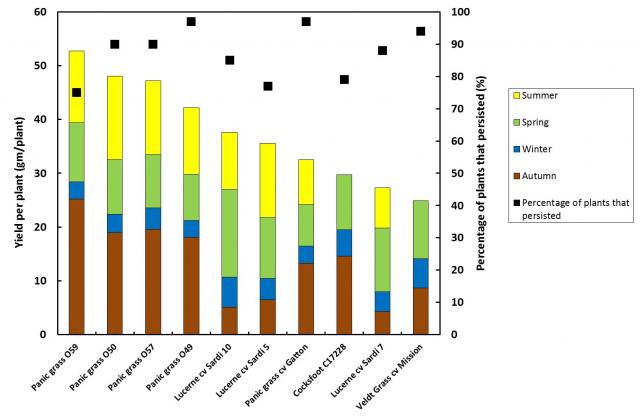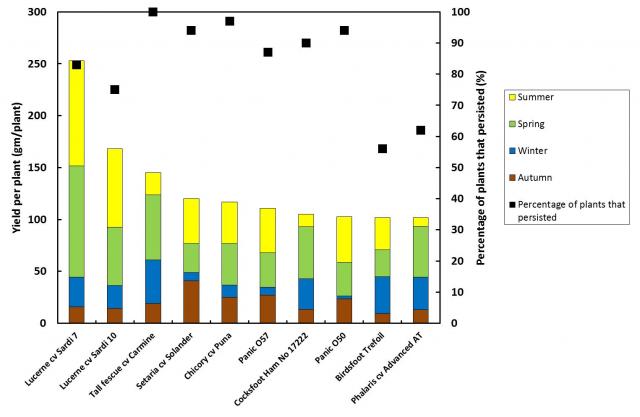Introduction
The EverGraze project focused on profitable perennial based farming systems in the high rainfall zone (greater than 500 millimetres). During the project it became apparent that we had insufficient knowledge to identify the right perennial for many situations; to address this we evaluated a range of species and cultivars in two contrasting environments (Manjimup and Gnowellen) with the goal of identifying lines that were both productive and persistent. Gnowellen and Manjimup were selected to contrast perennial performance in a summer wet coastal location compared to an inland site that receives the majority of its rainfall within the growing season. This article focuses on the performance of the commercial and soon to be released experimental lines.
Method
The site at Gnowellen was located near the town of Wellstead. The climate is cool temperate with a low risk of frost and a long-term average rainfall of less than 450 millimetres (mm). The site comprised of a sandy duplex soil with a pH (CaCI2) of 4.0 at 0-10 centimetres (cm) and 5.0 at 10-50cm; P (Colwell) 43 milligrams/kilogram (mg/kg); PBI 32.1; K (Colwell) 57mg/kg. During the period of the trial 2012 was characterised by a late break to the season with a yearly total of 311mm. The 2013 season was an early break with a total of 413mm received.
The second site was located 20 kilometres (km) south east of Manjimup. The climate is cool temperate with a high risk of frost and a long-term average rainfall of greater than 750mm. The Bureau of Meteorology recorded 746mm in 2012 and 818mm in 2013. Soil type was a brown loam over clay with a pH (CaCI2) of 5.4; P (Colwell) 79mg/kg; PBI 225.4; K (Colwell) 159mg/kg.
Both trial sites were hand sown with seed in the spring of 2011. Individual plots contained 36 plants in row spacings of 30 x 30cm apart on weed-matting. Measurements were only taken on the inside 16 plants; the 16 outside plants were buffers. Fertiliser was applied at both sites this included nitrogen, phosphorus and potassium and insects were controlled.
Results
For perennials to be economically viable they need to be both productive and persistent. Seasonal dry matter yields and persistence results for the highest ranked lines are summarised in Figures 1 and 2.


Gnowellen
At this site panic was the stand out species, providing substantial growth in summer and autumn, particularly in the second year once the plants had matured. Panic is a sub-tropical grass like kikuyu and therefore has a similar growth pattern throughout the year. The results suggest that it is well suited to this environment. Although it does not cover the soil surface like kikuyu, based on our observations it can potentially produce more green feed in summer. Unlike kikuyu panic does not go as rank as forage accumulates.
Lucerne, despite the acid soil, performed well once it had developed deep roots into the clay B horizon. Lucerne is particularly dependant on the correct conditions at establishment and requires rotational grazing and insect control to be productive and persistent.
Of the temperate grass species tested, perennial veldt grass and tall wheat grass (results not presented) were confirmed as proven performers in this environment. Cocksfoot also proved to be suited to the sandy soils with the improved lines highlighting its potential. Cocksfoot, while mostly summer dormant, can provide good autumn and early winter growth.
Summer-active tall fescue was not included at this site as it has been shown in previous trials not to persist. The winter-active types did persist but only produced modest amounts of forage. Phalaris didn’t perform as well as cocksfoot.
Manjimup
At this site lucerne produced the most dry matter — we did however have some difficulty establishing a full complement of 16 plants per plot. This allowed the remaining plants to have access to greater resources which may have flattered their performance. Lucerne can be a poor competitor in a sward and this was demonstrated on the property that hosted the trial with annual ryegrass competition leading to the demise of a lucerne paddock.
Chicory has been grown successfully in the Manjimup region, but persistence has been an issue. Of the two cultivars tested, Puna persisted the best. The variety Punta behaved as a bi-annual with the plants setting seed in the second year and not returning to a vegetative state. Birdsfoot trefoil, a perennial legume that is suited to wetter parts of the landscape, proved to be promising.
Of the temperate grasses, tall fescue is the standout performer on these soils in this rainfall zone. The trial confirmed that the summer-active variety Carmine, sown broadacre by the host farmer, is a top performer. Winter-active types are also suited to this environment and performed well in early winter compared to all other temperate grasses. Phalaris had a mixed performance with limited growth through autumn and early winter. Phalaris could be a consideration on waterlogged heavy soils.
The surprise performers were the sub-tropical bunch grasses as it was expected that they would not survive the cold winter. Several new panic grass lines were tested. The commercial cultivar, Gatton (results not presented), is a good benchmark for the new lines; it persisted and performed well in autumn and early summer providing out of season green feed. The issue for sub-tropical pastures in this environment is cold tolerance, particularly frosts. There was some evidence of plant damage and loss to frost, though the black weed-matting is likely to provide a softer test for cold tolerance than the paddock. The new panic lines (e.g. O59 and O49 – Figure 1) were developed by Geoff Moore (Department of Agriculture and Food, Western Australia) with specific attention to cold tolerance. Setaria was also tested at this site with both good persistence and out of growing season production. Setaria has similar growth to panic but with superior cold and water logging tolerance allowing some winter growth and would be suitable for companion planting with panic.
Further considerations
When considering perennials it is recommended that further information is sought for the species of interest. Producers need to understand whole farm suitability based on seasonal feed demand, the potential health risks to livestock as well as the required grazing management.
Acknowledgements
We would like to thank the farmers that hosted the trial sites; John and Danielle Mottram, Manjimup, and ‘Subasio Downs’, Gnowellen. We would also like to acknowledge all the organisations that have shown interest in our research and donated seed; Ballard Seeds, Heritage Seeds, Irwin Hunter & Co, Ridgeway Seeds and Wrightson Seeds, Tas Global Seeds, the Department of Agriculture and Food Western Australia, the Department of Environment and Primary Industries (DEPI) Victoria and the Commonwealth Scientific and Industrial Research Organisation (CSIRO).
EverGraze is a Future Farm Industries CRC project.
